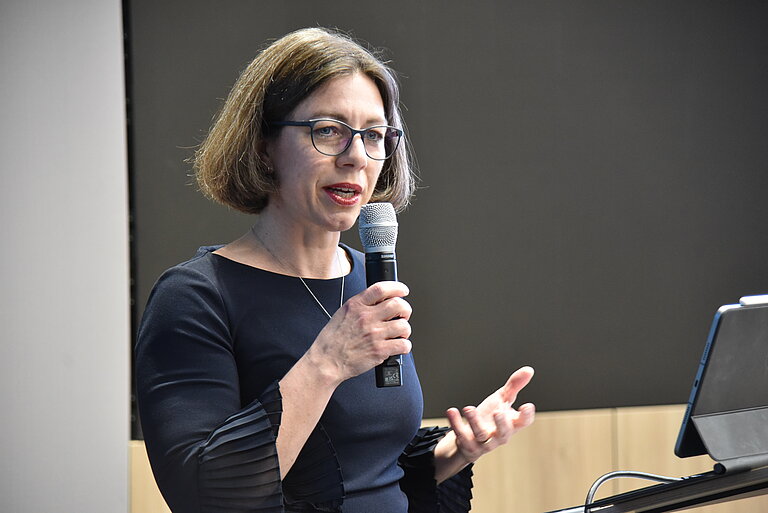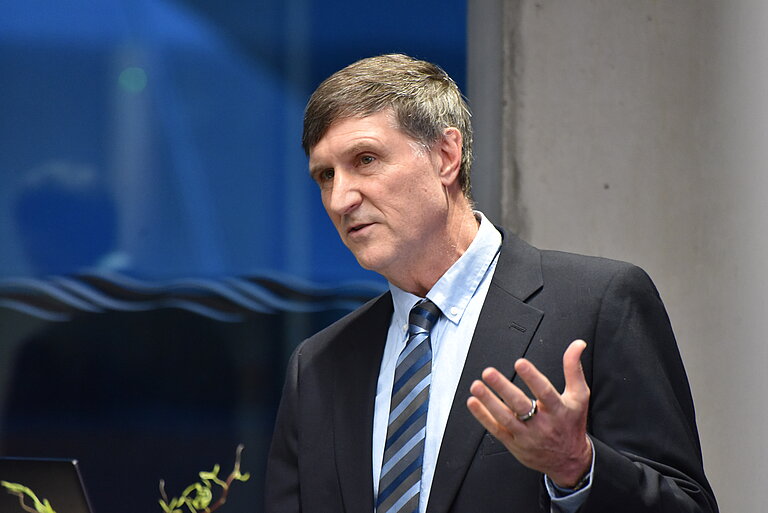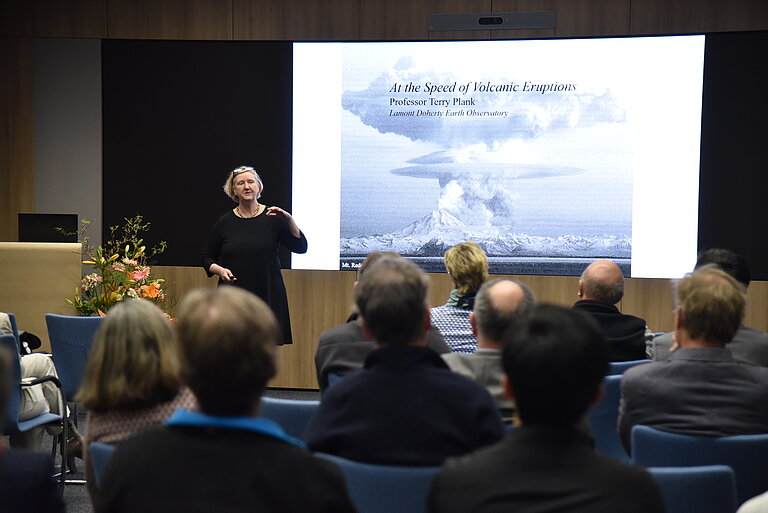Anna Niewerth
Phone: +49 (0) 431 600 2812
E-Mail: aniewerth(at)geomar.de
What Volcanic Crystals Reveal About the Speed of Eruptions
Geoscientist Prof. Dr Terry Plank awarded the 30th Excellence Professorship
What causes some volcanoes to be more explosive than others? What happens beneath volcanoes in the months, days, and minutes before an eruption? And how fast does magma race to the surface? Bubbles play an important role in addressing these questions. Explosive eruptions involve large volume fractions of gas that fling apart the molten rock. The gas driving explosive eruptions is primarily water (H2O).
As pressure decreases, gas bubbles in magma expand as it rises to the surface, causing the magma to move faster and the eruption to become more explosive. This phenomenon is already intuitive to anyone who has opened a bottle of soda. In order to defeat an explosive eruption from a shaken soda bottle, you know to open the cap slowly and let the gas leak out of the liquid. The same process could occur beneath volcanoes. Instead of releasing a cap, pressure is reduced in magmas naturally as they rise upward, where the mass of overburden is less. If magmas rise slowly, the buoyant gas bubbles may rise faster than the magma and leak out the volcanic vent, thereby defusing the explosion.
Deep beneath the volcanoes, growing crystals from the water-rich magmas preserve the water content in their crystal structure. They can also serve as timekeepers. At depth, crystals contain abundant water, in equilibrium with the melt. As the magma rises and attains lower pressure, the solubility of water drops, and water-rich bubbles form as the melt becomes drier. The crystals strive to lose their water to bubbles too, but chemical diffusion across crystals is slower than in melt, and the crystals become zoned. If the magma ascends slowly, the crystals have more time to lose their water, whereas if the magma ascends rapidly, only the rims of the crystals will lose their water, and the interior of the crystal will be unaffected. Using infrared spectroscopy, Dr Terry Plank, Professor of Geosciences at Columbia University in New York, together with her team, measured the zoning of water in the mineral Olivine and created a model to determine magma ascent rates for the first time. Researching these processes can help better understand and potentially forecast eruptions.
For her outstanding scientific achievements in the field of volcanology, Prof. Dr Terry Plank has received today the 30th Excellence Professorship from the Werner Petersen Foundation. The award, endowed with €20,000, is associated with a six-week research stay at the GEOMAR Helmholtz Centre for Ocean Research Kiel.
Dr h. c. Klaus-Jürgen Wichmann, Chairman of the Prof. Dr Werner Petersen Foundation: “For 15 years, our Excellence Initiative has aimed to recognize and support outstanding research achievements. Today's award of the 30th Excellence Professorship marks another milestone on this journey. We are proud to honour researchers like Professor Dr Terry Plank, who provide us with deep insights into the world of marine and geosciences.”
Professor Dr Katja Matthes, Director of GEOMAR, congratulated the awardee of the 30th Excellence Professorship on this well-deserved honour and thanked the foundation for its longstanding commitment: “We are deeply grateful for the long-standing partnership and tireless commitment of the Prof. Dr Werner Petersen Foundation to the promotion of science and research. For many years, your Excellence Initiative has reliably enriched GEOMAR by connecting us with renowned scientists from all over the world and facilitating exchange at the highest level. The awardees' research stays in Kiel enrich our national and international collaborations. This connection is a valuable asset for our research and contributes significantly to expanding the boundaries of our knowledge.”
Professor Dr Kaj Hoernle, Head of the Petrology and Geochemistry Working Group in the Dynamics of the Ocean Floor Research Division, emphasised the significance of the findings in his laudatory speech: “Throughout her illustrious career, Professor Plank has demonstrated a profound commitment to unravelling the mysteries of Earth's dynamic volcanic systems. Her pioneering work on volatiles, in particular water, in volcanic rocks and their minerals has significantly advanced our understanding of magmatic processes, geochemical cycles, and volcanic hazards, providing crucial insights into the inner workings of our planet.”
About Terry Plank
Professor Terry Plank is a Professor of Geosciences at Columbia University in New York, USA. She began her professional career at the University of Kansas and Boston University before becoming the first female professor in her field at Columbia University in 2008. She is one of the world's leading female scientists in volcano research, focusing on subduction zones and associated explosive volcanic eruptions. Professor Plank is a member of the National Academy of Sciences and has been awarded, among others, the Wollaston Medal by the Geological Society of London.
About the Petersen Foundation
The foundation, based in Schleswig-Holstein, aims to promote science, research, technology, and culture. One of its funding lines is the Excellence Professorships in close cooperation with GEOMAR, which honour international scientists with outstanding achievements. As part of the Excellence Initiative, top marine scientists from around the world can be invited to Kiel for research stays of about six weeks.

Awardee Dr Terry Plank, Professor of Geosciences at Columbia University in New York (right) and laudator Professor Dr Kaj Hoernle, Head of the Petrology and Geochemistry Group in the Research Division Ocean Floor Dynamics at GEOMAR. Photo: Thomas Eisenkrätzer, GEOMAR

Dr Christian Zöllner, deputy chairman and managing director (left), and Dr h..c. Klaus-Jürgen Wichmann, chairman of the Prof. Dr Werner-Petersen-Stiftung (right), together with GEOMAR director Professor Dr Katja Matthes (2nd from left) congratulate Professor Dr Terry Plank. Photo: Thomas Eisenkrätzer, GEOMAR

GEOMAR Director Professor Dr Katja Matthes thanked the Prof. Dr Werner Petersen Foundation for the long-standing partnership and commitment for the promotion of science and research. Photo: Thomas Eisenkrätzer, GEOMAR

Professor Dr Kaj Hoernle emphasised the groundbreaking work that has significantly advanced our understanding of volcanism. Photo: Thomas Eisenkrätzer, GEOMAR

Professor Dr Terry Plank spoke about the crucial role of gas bubbles in magma for the explosiveness of volcanic eruptions. Photo: Thomas Eisenkrätzer, GEOMAR
![[Translate to English:] Professor Dr. Terry Plank](/fileadmin/_processed_/0/4/csm_Petersen-Preis_Plank__37__2cca915bcf.jpg)
Professor Dr Terry Plank received the 30th Excellence Professorship from the Prof. Dr Werner Petersen Foundation for her research. Photo: Thomas Eisenkrätzer, GEOMAR

Professor Terry Plank is the 30th holder of the Werner Petersen Excellence Professorship. She was honoured for her outstanding scientific achievements in the field of volcanology. Photo: Matt Carr

Geoscientist Dr Terry Plank in front of Mount Carlisle in the Aleutian Island Arc during field work to collect samples from explosive volcanic deposits. Photo: D. Rasmussen

Dr Anna Barth, a member of Terry Plank's team, collecting samples of the 1992 and 1995 eruptions of Cerro Negro volcano in Nicaragua. Source: Anna Barth

Olivine crystals picked from volcanic samples, ready for chemical analysis. By zoning the water in the crystal, it was possible for the first time to determine the rate of magma ascent. Photo: Terry Plank

Currently active volcanoes: A total of 46 volcanoes worldwide are in a state of continuous eruption (as of 2 March 2024). Most of them are related to subduction of continental plates. Source: Smithsonian Global Volcanism Programme


